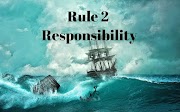Paragraph A
Nothing in these rules shall exonerate any vessel or the owner , master or crew thereof from the consequences of any neglect to comply with these rules or of the neglect of any precaution which may be required by the ordinary practice of seaman or of the circumstances of the case.
Explanation:
This part of the rule explains the responsibility of the vessel, her owner, master and crew.
This rule can be divided into the following sub parts for understanding;
Nothing will exonerate - Cannot be forgiven / pardoned .
If a vessel does not take avoiding action as required by these rules, the vessel will be held responsible for the accident which could happen due to its negligence in complying with these rules.
when a vessel takes avoiding action as required by these rules , she must take such precautions to ensure that her actions is taken well before the situation become critical, and her action should not create a dangerous situation for herself and for another vessel
A vessel may be involved in a close quarters situation with more than one vessel in a channel or traffic separation scheme and may find that the rules for collision avoidance may not give clear guidance with reference to the unique situation the vessel finds herself in. In such a situation the vessel shall take such necessary actions as required to avoid a collision. The vessel will not be able to defend itself by arguing that there was no guidance provided in the rules of the road (ROR).
- If a vessel does not comply with these rules, the vessel, owner master or crew shall not be able to escape from their responsibility towards the consequences that such neglect may result in.
- It also states that they will have to take such precautions as are required by the ordinary practice of seaman , even if they are not stated here.
- The circumstances may be such that they may not have been foreseen and hence there may not be any rules to cover the situation. In such case the vessel , her owner, her master and crew will take such precautions as may be required for the safety of the vessel. If they do not do so they will be held responsible for the consequences caused this failure.
Nothing will exonerate - Cannot be forgiven / pardoned .
If a vessel does not take avoiding action as required by these rules, the vessel will be held responsible for the accident which could happen due to its negligence in complying with these rules.
when a vessel takes avoiding action as required by these rules , she must take such precautions to ensure that her actions is taken well before the situation become critical, and her action should not create a dangerous situation for herself and for another vessel
A vessel may be involved in a close quarters situation with more than one vessel in a channel or traffic separation scheme and may find that the rules for collision avoidance may not give clear guidance with reference to the unique situation the vessel finds herself in. In such a situation the vessel shall take such necessary actions as required to avoid a collision. The vessel will not be able to defend itself by arguing that there was no guidance provided in the rules of the road (ROR).
This part of the rule has two important terms;
Paragraph B
In construing and complying with these rules due regards shall be had to all dangers of navigation and collision and to any special circumstances, including the limitations of the vessels involved which may make a departure from these rules necessary to avoid immediate danger.
- Construing - understanding
- Complying - following
Lets say she is about to alter her course , this alteration of course done as per colregs, shall not cause the vessel to run aground or be involved in another collision. She shall also take into account of her draft, trim,speed, blind sector , stopping distance , turning circle, etc while taking action. Thus the action must be taken well in advance to allow sufficient time to have the desired effect.
This part of the rule also states that a vessel may deviate from the colreg to take an action as will best aid to avoid collision and result in safe passing of vessels. The main theme of this part of the rule is to ensure safety of the vessel .
For instance, as per colregs a giveway vessel have to alter her course to starboard in case of a crossing situation. But if there is any danger (shallow waters, wreck) or due to her nature of cargo or by any means cannot go to starboard, she should take such action which will keep clear of that danger.







0 Comments